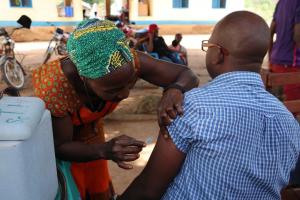South Sudan launches Yellow Fever vaccination campaign to stop outbreak in Sakure, Nzara County, Gbudue State
Yambio, 25 March 2019 – The Ministry of Health with support from the World Health Organization (WHO) and partners launched a reactive yellow fever (YF) vaccination campaign in Sakure, Nzara County, Gbudue State to vaccinate 19 578 individuals aged 9 months to 65 years against YF.
The vaccination campaign follows the declaration of a yellow fever outbreak on 29 November 2018, where a total of three laboratory confirmed cases with no deaths have been reported after investigations were carried out in Sakure payam.
In December 2018, a team comprising of epidemiologists, a public health officers, entomologists; laboratory specialists as well as risk communication experts carried out detailed epidemiological, laboratory, and entomological investigations to determine the magnitude of the outbreak, identify the vectors, assess the risk of an epidemic, and to initiate control measures to interrupt transmission and prevent further spread of the disease.
The reactive YF vaccination is part of the global strategy to Eliminate Yellow Fever Epidemics (EYE) by 2026, said Dr Olushayo Olu, WHO Representative for South Sudan. It serves to protect high-risk populations against the YF virus in the immediate term and will serve as a bridge towards the introduction of yellow fever vaccine into the routine immunization system in the long term.
YF is an acute viral haemorrhagic disease transmitted by infected mosquitoes. The "yellow" in the name refers to the jaundice that affects some patients. Symptoms of yellow fever include fever, headache, jaundice, muscle pain, nausea, vomiting and fatigue. A small proportion of patients who contract the virus develop severe symptoms and approximately half of those die within 7 to 10 days.
YF has an incubation period of 3-6 days following infection. Many people do not experience symptoms, but when these do occur, the most common are fever, muscle pain with prominent backache, headache, loss of appetite, and nausea or vomiting. In most cases, symptoms disappear after 3 to 4 days.
South Sudan last experienced a yellow fever outbreak in May 2003, in Imatong region of Torit County, with a total of 178 cases with 27 deaths (CFR 15%) in Imatong and Ikotos districts, Torit County.
With funding from Gavi, the Vaccine Alliance, European Union Humanitarian Aid (ECHO) and the United States Agency for International Development (USAID), South Sudan secured a total of 21 800 doses from the Global emergency yellow fever vaccine stockpile of the International Coordination Group (ICG) on vaccine provision.
Tel : +211923362401
Email: wamalaj [at] who.int (wamalaj[at]who[dot]int)
Tel: +211 922 555 222
Email: vpaul [at] who.int (vpaul[at]who[dot]int)
Tel: +211 956 779 467
Email: maleghemis [at] who.int (maleghemis[at]who[dot]int)
Communications Officer
WHO Rwanda
Mobile: +250 795 450 856
Email: ebrahimj [at] who.int (ebrahimj[at]who[dot]int)





